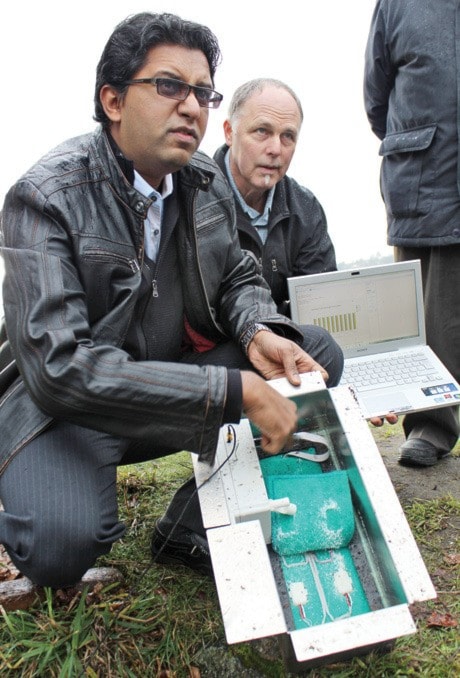With fresh water streams on campus and a migratory bird sanctuary at its front door, Royal Roads University seems like the perfect location to test oil filters for storm drains.
Officials at two universities and one environmental company agree and Tuesday the first of a series of combination filter/monitors was installed in a storm drain on campus as a part of a pilot project.
The filter not only stops oil from entering the drains, and eventually water systems, but it also incorporates new technology to monitor the filter and sound the proverbial alarms when oil is present.
A storm drain by the boathouse, eight drains in the lower parking lot and a drain by the fish ladder on RRU's campus will have the filters installed.
"That evasive, dripping oil is a major problem across Canada that we don't monitor," said Nancy Wilkin, director of sustainability for the university.
Camosun's mechanical engineering technology department played the part of designing the system's sensors. The two main people behind it, researchers Will Spaulding and Imtehaze Heerah, developed the oil-sensory technology from scratch, over the course of two years. They also devised a unique system to transmit the information the sensors collect.
"We can tell if it's debris or oil that's causing the problem," Spaulding said. "Either way you need maintenance, but one is a lot more important than the other."
A small computer monitors the sensors and transmits information via a wireless radio signal. The device also contains a level switch that will tell monitors if the drain is plugged. When a sensor is triggered it transmits data to a computer, and can also be programmed to deliver text message or email alerts.
The filter is made of a polymer substance (the exact composition of which is a trade secret) that is powdery when dry but turns into an impervious gel when it comes in contact with oil.
Ian Muir, founder of Petro Barriers, invented the oil collection technology about 12 years ago. He said the invention was a happy accident he stumbled upon while trying to figure out ways to reuse plastic from diapers.
"They blew a pipe. B��Ԫ������ַ� Hydraulic oil was all over the bloody place," said Muir. "They threw down some of this material and immediately it gelled and made a solid product."
The project also has a local touch, as RRU commerce graduate and now vice president of marketing and communications for Petro Barriers, Mike Ansley is one of the key figures behind the project.
"It's really exciting," Ansley said. "It's kind of the reason I went back. The alumni, the staff, the faculty, they all really do a good job of keeping in touch with you."
Units will also be installed at Camosun College and will also continue to be tested and developed in a lab setting.
The pilot project at RRU will run for the next year, after which Petro Barrier plans to incorporate the technology into its products.



